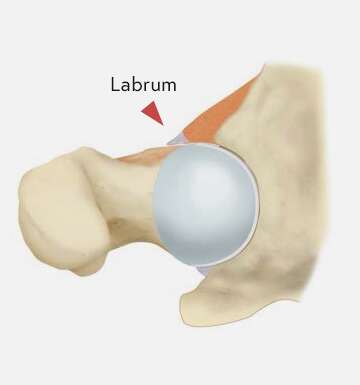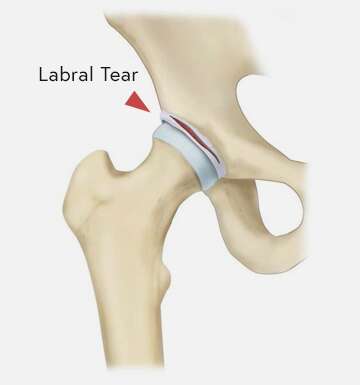Hip Labral Injuries: Five Facts About Your Hip Labral Injury and How You Can Overcome It
A common issue that can result in pain, instability, and restricted range of motion of the hip is an injury to the labrum. To properly manage this injury and get you back to your active lifestyle, it is crucial to understand the cause, symptoms, treatment options available to you, and ways to prevent future injury.
Here are 5 facts about labral injuries that you may not have known:
1. What is the labrum?
The labrum is a ring of very strong fibrocartilage, similar to a rubber band, that covers the outside portion of the hip socket. The hip is a ball-and-socket joint. The socket is a part of the hip bone called the acetabulum, and the head of the femur is the ball. Articular cartilage covers both the ball and the socket, and functions to reduce friction, allowing for smooth joint movement. The labrum functions to tighten the seal between the bones for joint stability; in other words, it acts as a suction cup to hold the ball of the femoral head in the socket.
Most times, labral injuries occur because of hip impingement in which the ball does not fit the socket very well. Hip impingement, or Femoral Acetabular Impingement (FAI), is caused by a genetic structural problem, specifically, bony overgrowth abnormalities (CAM and/or PINCER lesions) that lead to abnormal contact between the acetabulum and the femoral head. FAI is a common cause of hip and groin pain in active patients, as it can alter the normal biomechanics of the hip joint, leading to hip instability, labrum injury, and accelerated joint degeneration.

2. What are the symptoms of a labral injury?
Common symptoms of FAI with an associated labral tear include intermittent deep groin pain that is described as an aching pain, sharp stabbing pain when twisting, turning, or squatting (as when getting in or out of a car or chair), a dull ache from prolonged sitting or walking, a clicking or locking sound when the hip is moved, instability, decreased range of motion or stiffness, and limping. Due to compensation and altered gait mechanics because of the symptoms caused by FAI, patients can experience pain in other areas of the body including low back pain, pain in the buttocks, pain in the front of the thigh, and sometimes even knee pain.
Often, these symptoms may be mild at first. However, they can become more severe as time passes if not treated appropriately.
3. How do you diagnose a labral injury?
A labral injury is diagnosed with a physical examination, x-rays, and an MRI/CT scan. The x-rays will reveal abnormally shaped bones consistent with FAI, and the MRI will reveal the labral injury. A key finding on physical examination consistent with hip impingement and labral injury include a positive FADIR–pain with flexion, adduction, and internal rotation of the hip (bringing one’s knee to the chest and rotating it into her the opposite shoulder).

4. How do you treat a labral injury? Will I need surgery?
Some people can live active lives, never knowing they have FAI because they do not have any symptoms. However, when symptoms arise, both conservative and surgical treatments options can be considered when discussing what to do next.
In mild to moderate cases, symptoms can improve with nonsurgical treatment. This involves a change in activities to avoid movements that cause pain, using over-the-counter antiinflammatory medications to reduce pain and inflammation, and completing physical therapy.
Physical therapy sessions will include exercises designed to improve strength around your hips and pelvis, correct biomechanical abnormalities, and decrease surrounding inflammation. Corticosteroid injections can also help relieve pain. In some cases, chiropractic treatments, yoga, and other extreme range of motion activities can sometimes aggravate the condition.
When nonsurgical, conservative treatments do not relieve pain, surgical intervention may be indicated. Surgery can be performed in a minimally invasive procedure called a hip arthroscopy and is typically an outpatient procedure. Arthroscopy refers to a procedure done within a joint through small incisions using an arthroscope, or camera, to visualize the structures within. During the hip arthroscopy, your surgeon will repair the labrum using suture anchors to reattach the torn tissue. The hip impingement will also be addressed by shaving down the extra bony overgrowth. The overall success rate for hip arthroscopy and labral repair is 95%. Success of recovery largely depends on whether you adhere to post-operative instructions given by your surgical team regarding rehab exercises, activity levels, and lifestyle changes. Full recovery following surgery can be expected between 4 to 6 months, depending on the case.
5. How can I prevent a labral injury?
While some cases cannot be avoided due to certain activities, there are preventive measures you can take to reduce the risk of developing a hip labral tear. These include:
- Avoiding overtraining
- Stretching before exercise
- Wearing appropriate footwear while exercising
- Strengthening core muscles around your hips including glutes, hamstrings, and quads
- Performing exercises that target balance and stability around your hips.
- Taking regular breaks from activities that require repetitive motion, like running or jumping.
- Maintaining proper posture when sitting/standing/walking for long periods of time
- Maintaining a healthy weight, as excess weight puts extra stress on joints.
- Listening closely to body signals indicating pain, which could signal underlying issues needing attention sooner rather than later.
It is important to consult with an orthopedic medical professional when you start to notice the symptoms of a labral injury. Properly identifying and treating symptoms related to a labral injury early on can prevent further damage and allow you the chance to get back to the activities you enjoy.
If you or someone you know is suffering from a labral injury, take control today in managing your pain. At Midwest Orthopaedics at Rush, located in the heart of Chicago, Dr. Jorge Chahla, MD, PhD and his team are here to help you navigate your labral injury. We offer in-office and virtual consultations, and we will work diligently to ensure that you are well-informed of your injury and the options available to you. Our goal is to help you achieve YOUR goal.
